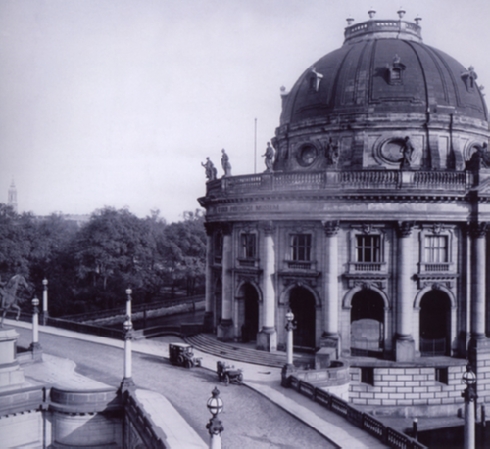James Simon and The Berlin Museums
Social commitment fades quickly from the memory of posterity, especially when it stems from a notoriously publicity-shy individual. A museum is much more adept at fulfilling this purpose, for a museum, and all related to it, is the institution of remembrance par excellence. During his epoch, James Simon was a key figure in the lanscape of Berlin's museums. This was also due to his close relationship with Wilhelm von Bode, the central figure in the museums' rise to international prominence.
Bode's large-scale museum plans
Simon's enthusiasm was devoted mainly to the Italian Renaissance. A unique symbiosis developed between his preferences as a collector and Bode's dream of a world-class museum; far removed from all collector rivalry, Simon served as a sort of Pied Piper, captivating more and more businessmen with Bode's large-scale museum plans. The idea: to create step by step a museum collection of worldwide significance with the support of private collectors.
Simon's spectacular decision
In 1900 Simon made a spectacular decision and announced plans to donate his Renaissance collection, including Andrea Mantegna's "Virgin with the Sleeping Child", to the state museums. He signed the major gift contract on Juns 27, 1904 - it was the largest legacy the state museums had received since that of Heinrich Schliemann. His only stipulation was that "the collection be housed together in a special gallery as part of the Italian sculpture collection for the next one hundred years."
Simon's generous gift was intended for the new Kaiser Friedrich-Museum (Emperor Friedrich-Museum), which the Prussian state energetically pushed to attain cultural prominence. Simon, the Prussian-Jewish patriot, did not hesitate to contribute; anything that would steer Prussian-Germany towards a peaceful, cultural competition with other nations would serve progress and support the transformation from an authoritarian military state into a future-oriented community. Simon never spoke publicity of his cultural-political motives. But one may confidently assume their existence, given his close, life-long connection to German liberalism. For Bode, Simon's decision was the best argument he could present to the other private collectors in his circle: someone had finally taken the first step. (...)"
(ibid., p. 14-15)
Andrea Mantegna (1431-1506) - The Virgin with the Sleeping Child
"Simon first became aware of the Mantegna in 1897. There was no doubt that the opportunity to acquire a masterpiece by the famous Renaissance painter would come only once and never again, and in view of the competition among collectors it was obvious that immediate action was necessary. Simon remained calm, however, and kept his coposure for five days - with the result that the price fell from 3.000 to 2.600 pounds sterling. (C.S.)"
(ibid., p. 92)
The most important painter of the Venetian Quattrocento
"Borm near Padua in 1431, Mantegna was the most important painter of the Venetian Quattrocento. Confrontation with the newly-rediscovered art of the ancient world hd a formative influence upon his work. His language of form is influenced by the sculptor Donatello, who was active in Padua from 1443 to 1453. Mantegna's "Virgin with the Sleeping Child" was inspired by Donatello's terracotta reliefs, whose warm closeness of mother and child create brilliant allegories of intimacy.
Montegna's Madonna expresses the epitome of motherly tenderness through the gesture of her hands. The infinitely melancholic expression of the mother of God reveals at the same time her knowledge of the impending Passion."
(ibid., p. 92)
Cultural World Politics
But Simon made cultural world politics by extending his interest to the Near East. In 1888 he began with an almost prophetic donation of finds from Tell el-Amarna to the Ägyptisches Museum (Egyptian Museum). At this time, around 1900, the increasing interest in the region was not only fanned by motives of antiquity: the German Empire was anxious to catch up with the older colonial powers of England and France with the construction of the Bagdad train route. The gaze of German elites turned expectantly to the ancient cultures of the Fertile Crescent and beyond. James Simon had met up with the founders of the Orient Comité as early as 1887, whose goal was to finance Middle-Eastern excavations for German museums. After ten years of mediocre success Simon took matters in hand and in 1898 founded a new vehicle of sponsorship, the Deutsche Orient-Gesellschaft (German Orient Society), in which state museums and influential circles should cooperate hand in hand.
Simon's idea was a sweeping success: the Orient became popular and the excavation of Babylon began under the direction of German scholars. And at the end, in spite of the aberrations of the time, the Museum Island became home to the Ishtar Gate and its processional way. Simon lived to attend the opening ceremony in 1930."
(ibid., p. 16)



